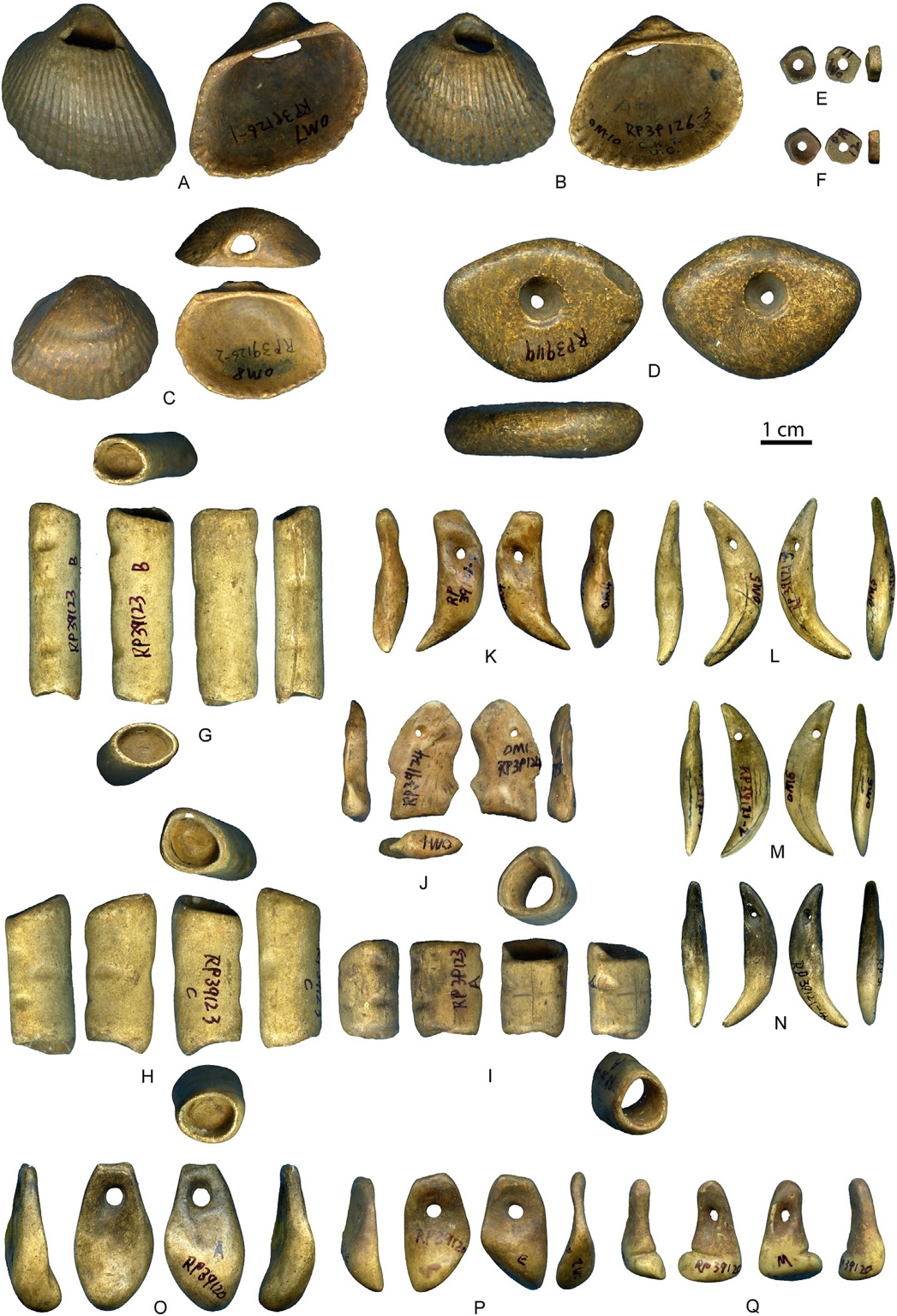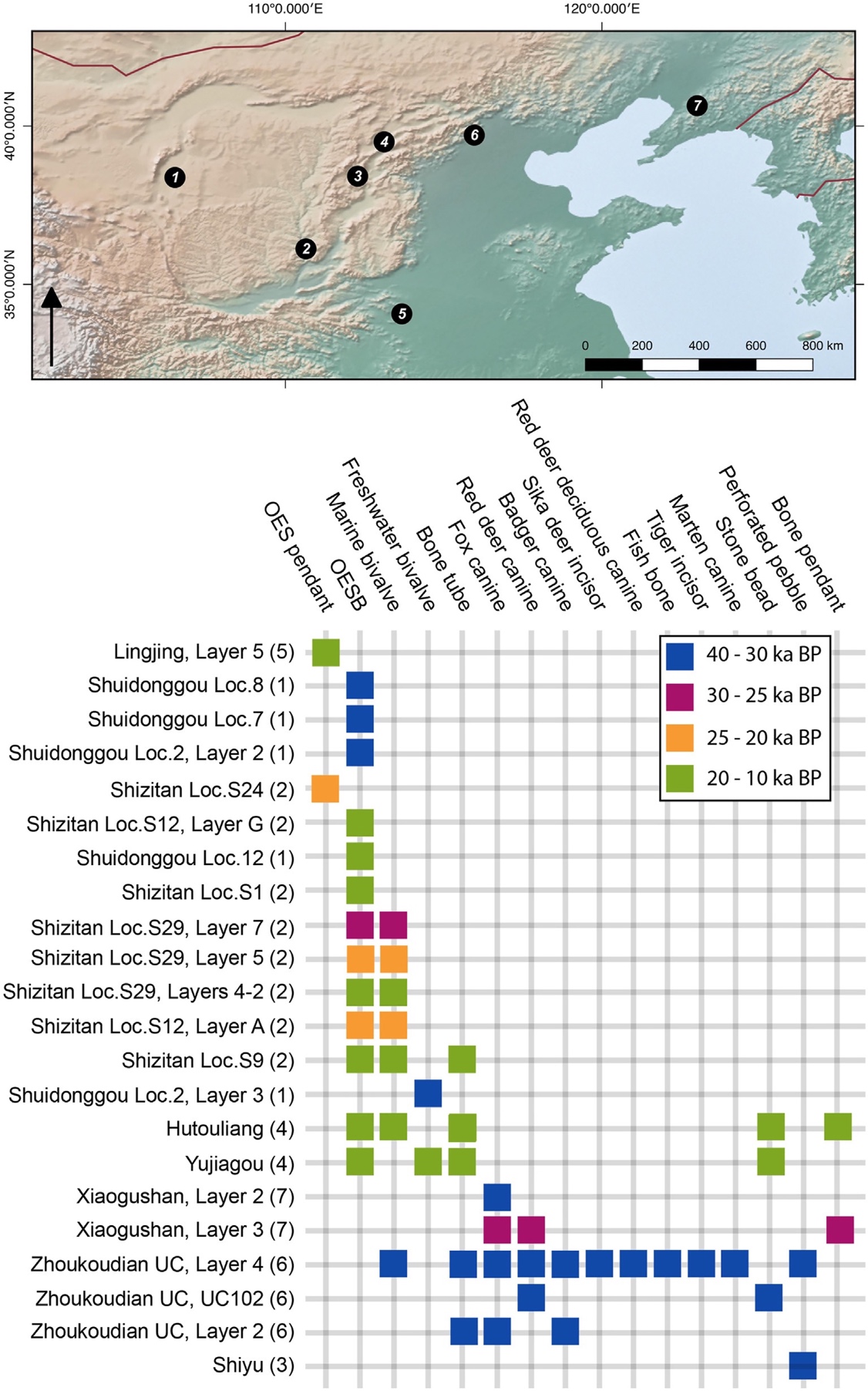山顶洞装饰品
发布时间:2021年12月30日
Journal of Human Evolution于2021年在线发表了对周口店山顶洞遗址出土的旧石器时代装饰品和赭石利用的研究成果,该研究工作由法国波尔多大学、北京自然博物馆和中国科学院古脊椎动物与古人类研究所的研究人员共同完成。
文章对周口店山顶洞遗址发现的装饰品进行了重新研究,并将其与中国北方其他旧石器时代遗址的装饰品进行比较。文章重新整理分析了裴文中先生对二战期间丢失的山顶洞出土装饰品的原始研究资料,并分析了其中的17件标本模型,以及目前在周口店遗址博物馆展出的三枚穿孔兽牙和两件未发表的装饰品,运用动物考古学、制作工艺和使用磨损分析对整个遗址地层中装饰行为及其变化的差异性进行了记录。獾、狐狸、马鹿、梅花鹿、貂、虎的牙齿以及鲤鱼骨、鸟骨、蚶属贝壳、石灰岩串珠和穿孔卵石是山顶洞人偏好的装饰品,对技术数据的多元分析强调了文化层和穿孔技术之间的对应关系。重新找到的三枚獾类犬齿的特征表明曾被缝在衣服上使用过,而非悬挂在项链或手链上,其上附着的红色残留物经过SEM-EDX和显微拉曼分析表明是作为赭石颜料使用的,并存在与技术差异相符的变化;余下两件牙齿虽是地层出土,但上面的穿孔是近期形成的,应当排除在山顶洞人类文化遗存之外。最后,文章对中国北方遗址中发现的旧石器时代晚期装饰品进行梳理,发现西部和东部遗址偏好的装饰品类型存在显著差异,并认为这可能反映了两种长期存在的服饰象征传统。
Zhoukoudian Upper Cave personal ornaments and ochre: Rediscovery and reevaluation
Francesco d’Errico a, b, *, Africa Pitarch Martí a, c, Yi Wei d, e, Xing Gao d, f, Marian Vanhaeren a, Luc Doyon a, g
a CNRS UMR5199 PACEA, Universite de Bordeaux, Pessac, CEDEX, France
b SFF Centre for Early Sapiens Behaviour (SapienCE), University of Bergen, Bergen, Norway
c Departament d'Arts I Conservacio-Restauracio, Facultat de Belles Arts, Universitat de Barcelona, Barcelona, Spain
d Centre for Excellence in Life and Paleoenvironment (CAS), Institute of Vertebrate Paleontology and Paleoanthropology, Chinese Academy of Sciences, Beijing, China
e Department of Scientific Research, Beijing Museum of Natural History, Beijing, China
f University of Chinese Academy of Sciences, Beijing, China
g Institute of Cultural Heritage, Shandong University, Qingdao, China
Personal ornaments have become a key cultural proxy to investigate cognitive evolution, modern human dispersal, and population dynamics. Here, we reassess personal ornaments found at Zhoukoudian Upper Cave and compare them with those from other Late Paleolithic Northern Chinese sites. We reappraise the information provided by Pei Wen Chung on Upper Cave personal ornaments lost during World War II and analyze casts of 17 of them, along with two unpublished objects displayed at the Zhoukoudian Site Museum and three original perforated teeth rediscovered at the Zhoukoudian Site Museum. We apply archeozoological, technological and use-wear analyses to document variation in ornamental practices and their change throughout the site stratigraphy. Badger, fox, red deer, sika deer, marten, and tiger teeth as well as carp bone, bird bone, Anadara shell, limestone beads, and perforated pebble appear to have been the preferred objects used as ornaments by Upper Cave visitors. Multivariate analysis of techno- logical data highlights a correspondence between cultural layers and perforation techniques, with radial incising being typical of layer L2 and bidirectional incising of L4. The three rediscovered badger canines display features suggesting they were sewed on clothing rather than suspended from necklaces or bracelets. Elemental scanning electron microscopy coupled with energy dispersive X-ray spectromety and mineralogical (m-Raman) analyses of red residues adhering to the rediscovered teeth indicate these objects were originally coated with ochre and identify variations that match differences in technology. The two ornaments exhibited at the Zhoukoudian Site Museum are ancient teeth that were recently perforated and should be excluded from the Upper Cave assemblage. A seriation of Late Paleolithic or- naments found at Northern Chinese sites identifies a clear-cut difference in preferred ornament types between western and eastern sites, interpreted as reflecting two long-lasting traditions in garment symbolic codes.

